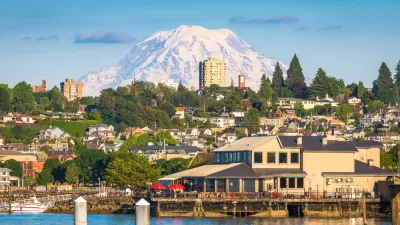Local leaders hope that streamlining permit processes and eliminating restrictive zoning regulations will set the groundwork for increased production of small and mid-sized multi-family housing.

As cities across the Commonwealth look to zoning reform to accommodate higher density and create more housing stock, Wyatt Gordon examines the "missing middle housing" programs being implemented in Norfolk and Arlington, both exploring options for expanding allowable housing types.
As covered here last week, Norfolk has published a Missing Middle Pattern Book designed to make new housing development more streamlined and affordable. "People often visualize adding more units means that the building will get bigger and bigger, but some of the examples identified in the pattern book demonstrate that you can have a house-scale building with multiple units in it," says Dan Parolek, author of Missing Middle Housing.
Meanwhile, Arlington, where 75 percent of residential land is zoned for single-family homes, is considering relaxing its zoning code to allow a broader diversity of multi-family buildings. According to Arlington's comprehensive planning section supervisor, Kellie Brown, "[t]he existing zoning doesn’t allow for more missing middle housing, so there are limited opportunities to increase our housing supply under many local ordinances today." Creating the opportunity for more housing means reforming other restrictive regulations such as parking requirements and minimum lot sizes.
"This is about meeting a need because developers are struggling to produce single-family homes at attainable price points,' says Parolek. "COVID was just the fuel on the fire of already increasing housing prices, meaning cities need to think creatively about how to deliver more housing for residents."
FULL STORY: How to bring the ‘missing middle’ to Virginia housing development

Planetizen Federal Action Tracker
A weekly monitor of how Trump’s orders and actions are impacting planners and planning in America.

Restaurant Patios Were a Pandemic Win — Why Were They so Hard to Keep?
Social distancing requirements and changes in travel patterns prompted cities to pilot new uses for street and sidewalk space. Then it got complicated.

Map: Where Senate Republicans Want to Sell Your Public Lands
For public land advocates, the Senate Republicans’ proposal to sell millions of acres of public land in the West is “the biggest fight of their careers.”

Maui's Vacation Rental Debate Turns Ugly
Verbal attacks, misinformation campaigns and fistfights plague a high-stakes debate to convert thousands of vacation rentals into long-term housing.

San Francisco Suspends Traffic Calming Amidst Record Deaths
Citing “a challenging fiscal landscape,” the city will cease the program on the heels of 42 traffic deaths, including 24 pedestrians.

California Homeless Arrests, Citations Spike After Ruling
An investigation reveals that anti-homeless actions increased up to 500% after Grants Pass v. Johnson — even in cities claiming no policy change.
Urban Design for Planners 1: Software Tools
This six-course series explores essential urban design concepts using open source software and equips planners with the tools they need to participate fully in the urban design process.
Planning for Universal Design
Learn the tools for implementing Universal Design in planning regulations.
Heyer Gruel & Associates PA
JM Goldson LLC
Custer County Colorado
City of Camden Redevelopment Agency
City of Astoria
Transportation Research & Education Center (TREC) at Portland State University
Camden Redevelopment Agency
City of Claremont
Municipality of Princeton (NJ)





























